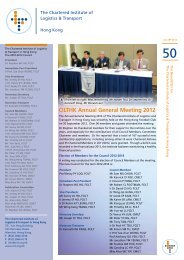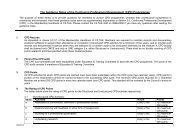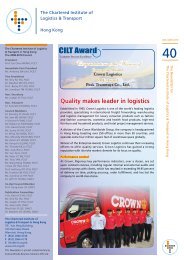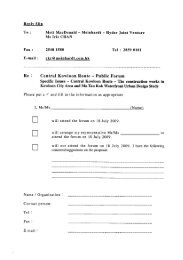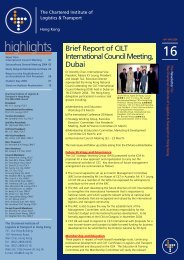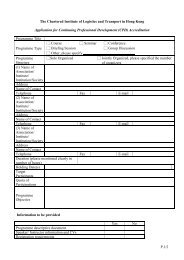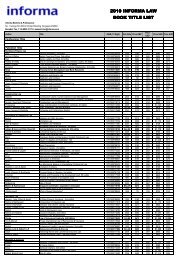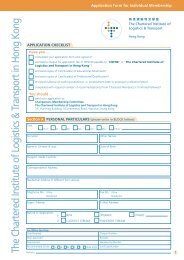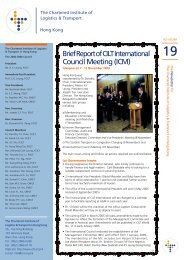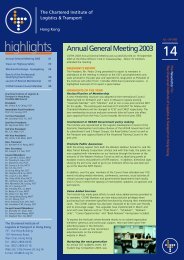CIT WORLD 8 TEMPLATE - The Chartered Institute of Logistics and ...
CIT WORLD 8 TEMPLATE - The Chartered Institute of Logistics and ...
CIT WORLD 8 TEMPLATE - The Chartered Institute of Logistics and ...
You also want an ePaper? Increase the reach of your titles
YUMPU automatically turns print PDFs into web optimized ePapers that Google loves.
22<br />
CILTWorld issue 9<br />
U.S. LIGHT RAIL REVILUTION<br />
Seattle is joining two dozen other U.S. cities<br />
that either have built or plan to build modern<br />
rail systems<br />
Rail Revolution<br />
IN CILT <strong>WORLD</strong> 07 we reported that “something<br />
strange has been happening in the United States<br />
… use <strong>of</strong> public transport – or transit, as<br />
Americans call it – has risen by five per cent, year<br />
on year.” In furtherance <strong>of</strong> this trend, several large<br />
U.S. cities are now involved in major light-rapid<br />
transit (LRT) or rail schemes. Some <strong>of</strong> these<br />
projects are summarised here.<br />
SEATTLE – This Washington state city has become<br />
the latest to join some two dozen other U.S. cities that<br />
either have built, or plan to build, modern light-rail<br />
systems.<br />
<strong>The</strong> 14-mile (22.4 km) Sound Transit line, known as<br />
Central Link – costing $2.44 billion (£1.5bn) – will be<br />
the largest public-works project in the city since the<br />
construction <strong>of</strong> Interstate highway 5 in the 1960s.<br />
After the groundbreaking on 10 November 2003<br />
Dwight Pelz, a Sound Transit board member whose<br />
council district includes much <strong>of</strong> the corridor,<br />
predicted: “We're confident it will be a countywide<br />
system within 20 years. Communities across the<br />
county are going to be clamouring for rail.”<br />
Sound Transit's trains will travel under downtown,<br />
sharing a 13-year-old tunnel with buses. <strong>The</strong> 1.3-mile<br />
(2 km) tunnel was built with rails for future light rail<br />
use, but they weren't insulated from the ground, <strong>and</strong><br />
the roadbed is six inches (15cm) too high to<br />
accommodate trains <strong>and</strong> newer buses. So Sound<br />
Transit will close the tunnel for two years for an $82<br />
million (£50m) retr<strong>of</strong>it that includes a new “stub<br />
tunnel” where trains can turn around.<br />
“World class”<br />
Officials have said the line will help make Seattle a<br />
“world-class city.”<br />
When completed in 2009, the Central Link line, from<br />
Westlake Centre to Tukwila, will serve mainly lowerincome<br />
neighbourhoods, where public-housing<br />
projects are being rebuilt <strong>and</strong> exp<strong>and</strong>ed to put<br />
thous<strong>and</strong>s within walking distance <strong>of</strong> stations.<br />
Critics have called the line a “train to nowhere”<br />
because it stops short <strong>of</strong> Seattle-Tacoma International<br />
Airport (SeaTac) <strong>and</strong> serves only a few<br />
neighbourhoods. But supporters reply that Denver,<br />
Salt Lake City, Dallas <strong>and</strong> other cities that built an<br />
initial line later built others. <strong>The</strong> original Seattle plan<br />
called for a 21-mile line from the University District to<br />
SeaTac Airport. Cost overruns forced the agency to<br />
scale back three years ago. But as work on the project<br />
began in November 2003, Sound Transit reiterated its<br />
goal to get light rail to the airport by 2011.<br />
SALT LAKE <strong>CIT</strong>Y – In Utah, a $500 million<br />
(£303m) line, forming the first part <strong>of</strong> a new<br />
commuter route north <strong>of</strong> Salt Lake City, has just<br />
got under way. <strong>The</strong> 43-mile (69 km) stretch <strong>of</strong><br />
route will include nine stops from Salt Lake City to<br />
Pleasant View in Weber County, <strong>and</strong> should be<br />
running by 2007.<br />
Last year, the transit authority UTA purchased a<br />
right-<strong>of</strong>-way corridor from Union Pacific Railroad.<br />
<strong>The</strong>100-foot-wide corridor runs parallel to<br />
Interstate Highway 15 from Payson in Utah County<br />
north to Weber County.<br />
<strong>The</strong> $500 million cost will be funded from a variety<br />
<strong>of</strong> sources. Federal U.S. transportation funds may<br />
match as much as 50% <strong>of</strong> the project cost, with<br />
the rest coming from voter-approved quarter-cent<br />
sales tax revenues from Weber, Davis <strong>and</strong> Salt Lake<br />
counties.<br />
In Salt Lake City, construction on the city's<br />
intermodal centre is already under way to link<br />
together bus, light-rail, commuter rail <strong>and</strong> taxi<br />
services. <strong>The</strong> existing Delta Centre TRAX line will<br />
be extended south to pull up along the commuter<br />
train platform.<br />
A second train platform is also planned to link with<br />
the future light-rail line to Salt Lake International<br />
Airport.<br />
UTA plans to eventually extend the commuter rail<br />
system to Provo, possibly by 2012, <strong>and</strong> up into<br />
Brigham City, but no date has been projected.<br />
HOUSTON (Texas) – With its first light rail service<br />
due to begin January 1 2004 – on a 7.5 mile (12<br />
km) line, costing $300 million (£180m), which will<br />
connect downtown Houston to Reliant Stadium –<br />
the Metropolitan Transit Authority is planning to<br />
make buses connect efficiently with the new rail<br />
service, instead <strong>of</strong> duplicating it. Annual operating<br />
savings <strong>of</strong> over $2 million (£1.2m) are forecast.<br />
Meanwhile, the MTA (Metro) has voted to begin<br />
immediately implementing a $7.5 billion (£4.5bn)<br />
transit-expansion plan – narrowly endorsed by<br />
51.7% <strong>of</strong> voters – but cautioned it will take four<br />
years <strong>of</strong> planning, design <strong>and</strong> construction before<br />
the next trains are running. Metro has plans to<br />
build a total <strong>of</strong> 73 miles (117 km) <strong>of</strong> new rail routes<br />
by 2025.<br />
<strong>The</strong> next stage is 22 miles (35 km) <strong>of</strong> route,<br />
financed by $640 million (£388m) in bonds. <strong>The</strong><br />
New rail systems are seen as a<br />
solution to growing traffic<br />
congestion in American cities.<br />
first extension will be along a north corridor from<br />
the University <strong>of</strong> Houston-Downtown, scheduled<br />
to open in 2008. A line to the south-east comes<br />
next in 2009, followed by one to the East End in<br />
2010. An inner south-west line will open for<br />
passengers in 2012.<br />
<strong>The</strong> transit authority is preparing an application for<br />
federal funding, which it plans to submit to the<br />
Federal Transit Authority in 2004.<br />
Obtaining FTA money requires four steps:<br />
identifying the best transit option, engineering <strong>and</strong><br />
environmental review, <strong>and</strong> preliminary engineering<br />
<strong>and</strong> final design. Only after this process, which <strong>of</strong>ten<br />
takes four years or more, can an agency become<br />
eligible for money.<br />
TENESSEE – Construction has been delayed from<br />
January until March 2004 <strong>of</strong> the first leg <strong>of</strong> a 32-mile<br />
Nashville-Lebanon commuter route. <strong>The</strong> $37.6<br />
million (£22.8m) rail line is set to open in 2005.<br />
Meanwhile, rail planners are still searching for a<br />
catchy name for the new commuter rail system,<br />
which is planned to include five lines from area<br />
suburbs into Nashville in the coming years. Proposed<br />
names ''T-Rail,'' ''Tennessee Rail Express,'' or ''T-<br />
REX'' haven't drawn much enthusiasm. Marketing<br />
consultants are to enlist residents for focus groups to<br />
help select a name in the coming months.<br />
JERSEY <strong>CIT</strong>Y – Spring 2004 should see completion<br />
<strong>of</strong> the next extension <strong>of</strong> the new light rail line<br />
through Jersey City, New Jersey.<br />
Service to Bayonne's 22nd Street Light Rail station<br />
began in November 2003. <strong>The</strong> next extension will<br />
be north to Lincoln Harbour, by spring 2004, <strong>and</strong><br />
will include stations at 2nd <strong>and</strong> 9th streets in<br />
Hoboken. An extension farther north, to Tonnelle<br />
Avenue in North Bergen, is to be completed by<br />
summer 2004.<br />
<strong>The</strong> new LRT route, built at a cost <strong>of</strong> $1 billion<br />
(£600m) <strong>and</strong> operated by NJ Transit, runs roughly<br />
along the Hudson River waterfront through Jersey<br />
City. 17,000 riders already use the line daily.<br />
HONOLULU – Out in the mid Pacific, plans are<br />
under way for light rail transit. Following a Hawaii<br />
State Governor's task force recommendation for a<br />
$2.6 billion (£1.6bn) light-rail transit system for<br />
O'ahu, the City Council has now called for a study <strong>of</strong><br />
a proposal that would connect West O'ahu to<br />
downtown Honolulu.



